 |
 |
 |
 |
 |
 |
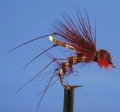 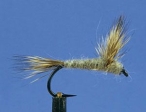 |
For hundreds of years anglers have been using
'models' of natural insects to catch trout. These models
are often very elaborate:
|
 |
|
Home page About us Instruction Guiding Locations map Gift vouchers Prices Articles Contact us Accommodation Links |
- Ethology is a branch of biology which studies animal behaviour
- Ethology rejects excessively anthropomorphic interpretation of animal behavior
- Lloyd Morgan's Canon is a formal statement of this
rejection:
"In no case is an animal activity to be interpreted in terms of higher psychological processes, if it can be fairly interpreted in terms of processes which stand lower in the scale of psychological evolution and development" - In other words a simple explanation is better than a more complex one
- One of the founding fathers of ethology - Konrad Lorenz - identified Fixed Behavioural Patterns
- Fixed Behavioural Patterns are instinctive behaviours that occur in the presence of identifiable stimuli called sign stimuli or releasing stimuli
- A well-known example of sign stimuli eliciting fixed behavioural patterns is Tinbergen's study of courtship and aggression in sticklebacks
- You may be interested in these articles which discuss ethology and sign stimuli from a more academic perspective
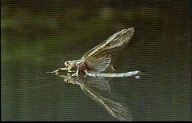
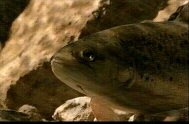
|
"Ethology and fish behaviour" In Spring male sticklebacks change colour, establish a territory and build a nest. They attack male sticklebacks that enter their territory, but court females and entice them to enter the nest to lay eggs. |
|||||||||||||||||||||||||||||||||||||||||||||||||||||||
|
This diagram shows Tinbergen's main findings. Male sticklebacks:
|
|||||||||||||||||||||||||||||||||||||||||||||||||||||||
|
|
|||||||||||||||||||||||||||||||||||||||||||||||||||||||
| "The
Hare's Ear
Puzzle"
|
Skues
wrote: "At one time the late Mr. F.M. Halford was a great
advocate of the Gold-ribbed Hare's Ear, but I believe that
latterly his enthusiasm for precise imitation induced him to give
it up, successful pattern though he knew it to be, because he could not explain its
success to
his satisfaction." (italics added) Can we use ethological concepts to explain the success of the GRHE?
Remember that a male stickleback will:
|
||||||||||||||||||||||||||||||||||||||||||||||||||||||
|
|
|||||||||||||||||||||||||||||||||||||||||||||||||||||||
"The
ubiquitous
Pheasant Tail"  Sawyer Pheasant Tail and Grey Goose nymphs |
We can apply
an ethological
approach to explore the possibility that several flies made from
pheasant tail fibres incorporate sign stimuli that elicit feeding
behaviour in trout. Frank Sawyer introduced the Pheasant Tail nymph - a simple fly construced from copper wire and dark pheasant tail fibres to imitate Baetis nymphs - which is cast upstream of the trout so it sinks to trout's level. Then the rod tip is lifted so that the fly ascends in the water in front of the fish- the 'induced take' technique. Sawyer (1979) commented: "General shape
and
colouration, together with the right size is of greater
importance than an exact copy. My two universal patterns, as I
call them, are the Pheasant Tail and the Grey Goose. The Pheasant
Tail serves for the darker coloured nymphs and the Gray Goose for
the lighter ones."
|
||||||||||||||||||||||||||||||||||||||||||||||||||||||
  Cove's Pheasant Tail and Teeny's Nymph |
The effectivenees of simple flies constructed from pheasant tail fibres is not restricted to English chalkstreams. Arthur Cove's Pheasant Tail was developed to imitate 'buzzers' (chironomid midges) on Eyebrook reservoir. The American Al Troth based his Pheasant Tail nymph on Sawyer's original pattern but used peacock herl as thorax material. The Teeny Nymph is another example of a simple but effective trout fly which may imitate a shrimp. Size and colour variations of Jim Teeny's basic pattern have been responsible for catching 25 IGFA (International Game Fish Association) fresh and saltwater world records. |  Troth's Pheasant Tail |
|||||||||||||||||||||||||||||||||||||||||||||||||||||
|
|
|||||||||||||||||||||||||||||||||||||||||||||||||||||||
The
simplicity of these flies
suggests several candidates for sign stimuli that elicit a
trout's feeding response:
|
|||||||||||||||||||||||||||||||||||||||||||||||||||||||
|
|
|||||||||||||||||||||||||||||||||||||||||||||||||||||||
This table
presents the design
elements in several 'classic' artificial flies used for
sub-surface presentation to trout in rivers and stillwaters.
All of these successful classic trout flies have the following design elements in common:
Thus several different sign stimuli may act together to trigger the trout's feeding behaviour. Trout may 'add-up' sign stimuli to determine if an object is edible. This would be an example of the law of heterogeneous summation which predicts that incorporating several sign stimuli into an artificial fly could increase its attractiveness to trout. In fact, the law suggests that these artificial flies could be more attractive to trout than the natural insects they are supposed to represent. |
|||||||||||||||||||||||||||||||||||||||||||||||||||||||
|
|
|||||||||||||||||||||||||||||||||||||||||||||||||||||||
|
|||||||||||||||||||||||||||||||||||||||||||||||||||||||
|
|
|||||||||||||||||||||||||||||||||||||||||||||||||||||||
|
|
|||||||||||||||||||||||||||||||||||||||||||||||||||||||
- Sawyer "Nymphing in the Classic Style" in Migel & Wright (Eds) "The Masters on the Nymph", 1979, published by Ernest Benn, London.
- Zern "Bye-Bye, Wet Fly?" in Migel & Wright (Eds) "The Masters on the Nymph", 1979, published by Ernest Benn, London.
- Roy Christie's article on the Copper Wire Hare's Ear
- Skues, "The way of a trout with a fly" published by A and C Back, 4th edition, 1949, p 91
- Sawyers nymphs
- Bob Ireton article on tying and fishing the Teeny nymph
- Jim Teeny's flies. Look under 'Fishing Tips' for Jim's video showing how to tie his Teeny nymph
- An appreciation of Jim Teeny and his nymph by Peter Cockwill originally published in "Flydresser" contains clear and detailed tying instructions
- The IGFA (International Game Fish Association) website
- Loren Williams's clearly illustrated article on tying Al Troth's American Pheasant Tail nymph
- Martin Cottis' article on tying Cove's Pheasant Tail Nymph
- In a 'spoof' article (B J Britton, J Grimley Evans and J M Potter,"Does the fly matter? The CRACKPOT study in evidence based trout fishing", British Medical Journal, 1998) the authors compared the GRHE against other dry flies on a well stocked chalkstream. The authors are cordially invited to replicate their findings on a population of wild brown trout!
- Rim Chung's website with tying instructions for his RS2 nymph and using forceps as a vice
- Snowbee-Waldron fly tying vice
- A collection of flies tied by Al Troth including his pheasant tail nymph
 The
ethologist Tinbergen used crude 'models' of
sticklebacks to investigate which features of male and female
sticklebacks elicited attack and courtship behaviour from male
sticklebacks.
The
ethologist Tinbergen used crude 'models' of
sticklebacks to investigate which features of male and female
sticklebacks elicited attack and courtship behaviour from male
sticklebacks.
 and
court this
and
court this 
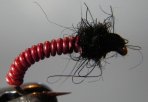 In his book
'Trout Flies' Dave Hughes remarked "Many folk think
that if fish aren't taking their nymphs, they need to change
flies. Most often all they need to do is change depth. Fish a
foot or two deeper, and suddenly the same fly is remarkably
effective." The Brassie (shown on the left) is an example of
a simple fly that will sink quickly.
In his book
'Trout Flies' Dave Hughes remarked "Many folk think
that if fish aren't taking their nymphs, they need to change
flies. Most often all they need to do is change depth. Fish a
foot or two deeper, and suddenly the same fly is remarkably
effective." The Brassie (shown on the left) is an example of
a simple fly that will sink quickly.

 Final
thought
Final
thought